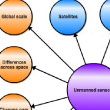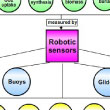Ocean Literacy Principle 7B: Understanding the ocean is more than a matter of curiosity. Exploration, inquiry and study are required to better understand ocean systems and processes.
| |
|
|
|
| Scientist map | | Consensus map |
How Can Robotic Sensors Help Us Understand Climate Change & the Ocean Carbon Cycle? Benjamin Twining (scientist) and students Susie Arnold, Beth Campbell, Keri Lindberg, and Phoebe Jekielek
Save map to CMB: Scientist Map | Consensus Map
Download (pdf): Scientist Map | Consensus Map
On his first concept map, Dr. Twining tried to focus on sensors because many people in the general public may not understand what they are or how they are used by scientists. He felt it was important to include examples of the wide variety of information provided by sensors. His team decided to edit some of his terminology. They suggested re-arranging his map. His 'left-to-right' map became a 'top-to-bottom' map. It became more hierarchical in nature. They decided to include more examples of sensor types and the data they collect, but also what these data reveal about the ocean. When his group attempted to present the revised map to high school students the power went out. They managed to present the concept map with a few cleverly improvised visual aids: a banana served to illustrate the function of a glider, and a large pepper mill became a drifter. The graduate students did a great job presenting this complex topic to the high school audience.
|







